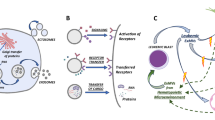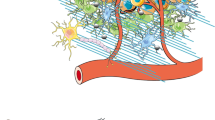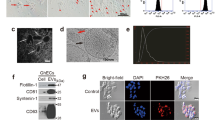Abstract
Aggressive human brain tumours (gliomas) often express a truncated and oncogenic form of the epidermal growth factor receptor, known as EGFRvIII. Within each tumour only a small percentage of glioma cells may actually express EGFRvIII; however, most of the cells exhibit a transformed phenotype1. Here we show that EGFRvIII can be 'shared' between glioma cells by intercellular transfer of membrane-derived microvesicles ('oncosomes'). EGFRvIII expression in indolent glioma cells stimulates formation of lipid-raft related microvesicles containing EGFRvIII. Microvesicles containing this receptor are then released to cellular surroundings and blood of tumour-bearing mice, and can merge with the plasma membranes of cancer cells lacking EGFRvIII. This event leads to the transfer of oncogenic activity, including activation of transforming signalling pathways (MAPK and Akt), changes in expression of EGFRvIII-regulated genes (VEGF, Bcl-xL, p27), morphological transformation and increase in anchorage-independent growth capacity. Thus, membrane microvesicles of cancer cells can contribute to a horizontal propagation of oncogenes and their associated transforming phenotype among subsets of cancer cells.
This is a preview of subscription content, access via your institution
Access options
Subscribe to this journal
Receive 12 print issues and online access
$209.00 per year
only $17.42 per issue
Buy this article
- Purchase on Springer Link
- Instant access to full article PDF
Prices may be subject to local taxes which are calculated during checkout




Similar content being viewed by others
References
Biernat, W., Huang, H., Yokoo, H., Kleihues, P., & Ohgaki, H. Predominant expression of mutant EGFR (EGFRvIII) is rare in primary glioblastomas. Brain Pathol. 14, 131–136 (2004).
Pilzer, D., Gasser, O., Moskovich, O., Schifferli, J. A., & Fishelson, Z. Emission of membrane vesicles: roles in complement resistance, immunity and cancer. Springer Semin. Immunopathol. 27, 375–387 (2005).
Janowska-Wieczorek, A. et al. Microvesicles derived from activated platelets induce metastasis and angiogenesis in lung cancer. Int. J. Cancer; 113, 752–760 (2005).
Del Conde, I., Shrimpton, C. N., Thiagarajan, P., & Lopez, J. A. Tissue-factor-bearing microvesicles arise from lipid rafts and fuse with activated platelets to initiate coagulation. Blood. 106, 1604–1611 (2005).
Mack, M. et al. Transfer of the chemokine receptor CCR5 between cells by membrane-derived microparticles: a mechanism for cellular human immunodeficiency virus 1 infection. Nature Med. 6, 769–775 (2000).
Yu, J. L. et al. Oncogenic events regulate tissue factor expression in colorectal cancer cells: implications for tumor progression and angiogenesis. Blood 105, 1734–1741 (2005).
Yu, X., Harris, S. L., & Levine, A. J. The regulation of exosome secretion: a novel function of the p53 protein. Cancer Res. 66, 4795–4801 (2006).
Cavenee, W. K. Genetics and new approaches to cancer therapy. Carcinogenesis 23, 683–686 (2002).
Al-Nedawi, K., Szemraj, J., & Cierniewski, C. S. Mast cell-derived exosomes activate endothelial cells to secrete plasminogen activator inhibitor type 1. Arterioscler. Thromb. Vasc. Biol. 25, 1744–1749 (2005).
Feldkamp, M. M., Lau, N., Rak, J., Kerbel, R. S., & Guha, A. Normoxic and hypoxic regulation of vascular endothelial growth factor (VEGF) by astrocytoma cells is mediated by Ras. Int. J. Cancer 81, 118–124 (1999).
Viloria-Petit, A. M. et al. Neutralizing antibodies against EGF and ErbB-2/neu receptor tyrosine kinases downregulate VEGF production by tumor cells in vitro and in vivo: angiogenic implications for signal transduction therapy of solid tumors. Am. J. Pathol. 151, 1523–1530 (1997).
Bergsmedh, A. et al. Horizontal transfer of oncogenes by uptake of apoptotic bodies. Proc. Natl Acad. Sci. USA 98, 6407–6411 (2001).
Ramnarain, D. B. et al. Differential gene expression analysis reveals generation of an autocrine loop by a mutant epidermal growth factor receptor in glioma cells. Cancer Res. 66, 867–874 (2006).
Blume-Jensen, P. & Hunter, T. Oncogenic kinase signalling. Nature 411, 355–365 (2001).
Acknowledgements
This project was supported by grants to J. R. from the National Cancer Institute of Canada, the Canadian Cancer Society and the Terry Fox Foundations, and by a CIHR grant to A. G.; J. R. is the Jack Cole Chair in Paediatric Oncology. Infrastructure contribution came from FRSQ. We are most grateful to our families for their support.
Author information
Authors and Affiliations
Contributions
K. A. N. provided conceptual input, designed and performed experiments, analysed the data and wrote the manuscript; B. M. contributed to conceptual input, performed experiments and coined the term 'oncosomes'; V. L. and L. M. performed experiments; J. M. and A. G. provided reagents and expertise (A. G. in brain tumours), and analysed data; J. R. designed experiments, provided conceptual input and supervision, and wrote the manuscript.
Corresponding author
Ethics declarations
Competing interests
The authors declare no competing financial interests.
Supplementary information
Supplementary Information
Supplementary Figures S1, S2, S3, S4, S5 and Supplemental Materials & Methods (PDF 1691 kb)
Rights and permissions
About this article
Cite this article
Al-Nedawi, K., Meehan, B., Micallef, J. et al. Intercellular transfer of the oncogenic receptor EGFRvIII by microvesicles derived from tumour cells. Nat Cell Biol 10, 619–624 (2008). https://doi.org/10.1038/ncb1725
Received:
Accepted:
Published:
Issue Date:
DOI: https://doi.org/10.1038/ncb1725
This article is cited by
-
Soluble receptors in cancer: mechanisms, clinical significance, and therapeutic strategies
Experimental & Molecular Medicine (2024)
-
Cytoneme-mediated transport of active Wnt5b–Ror2 complexes in zebrafish
Nature (2024)
-
Diagnostic, prognostic, and therapeutic potential of exosomal microRNAs in renal cancer
Pharmacological Reports (2024)
-
Candida albicans extracellular vesicles trigger type I IFN signalling via cGAS and STING
Nature Microbiology (2024)
-
Relevance of multilamellar and multicompartmental vesicles in biological fluids: understanding the significance of proportional variations and disease correlation
Biomarker Research (2023)



